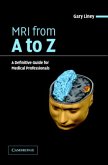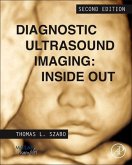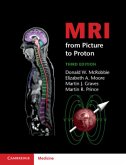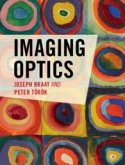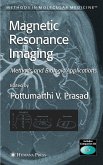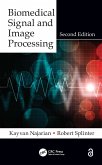Andrew C Papanicolaou
Clinical Magnetoencephalography and Magnetic Source Imaging
Andrew C Papanicolaou
Clinical Magnetoencephalography and Magnetic Source Imaging
- Gebundenes Buch
- Merkliste
- Auf die Merkliste
- Bewerten Bewerten
- Teilen
- Produkt teilen
- Produkterinnerung
- Produkterinnerung
The first volume on clinical magnetoencephalography and magnetic source imaging, measuring the magnetic fields generated by neuronal activity in the brain.
Andere Kunden interessierten sich auch für
![MRI from A to Z MRI from A to Z]() Gary LineyMRI from A to Z73,99 €
Gary LineyMRI from A to Z73,99 €![Diagnostic Ultrasound Imaging: Inside Out Diagnostic Ultrasound Imaging: Inside Out]() Thomas L. SzaboDiagnostic Ultrasound Imaging: Inside Out111,99 €
Thomas L. SzaboDiagnostic Ultrasound Imaging: Inside Out111,99 €![Ultra-Low Field Nuclear Magnetic Resonance Ultra-Low Field Nuclear Magnetic Resonance]() Robert KrausUltra-Low Field Nuclear Magnetic Resonance257,99 €
Robert KrausUltra-Low Field Nuclear Magnetic Resonance257,99 €![MRI from Picture to Proton MRI from Picture to Proton]() Donald W. McRobbieMRI from Picture to Proton102,99 €
Donald W. McRobbieMRI from Picture to Proton102,99 €![Imaging Optics Imaging Optics]() Joseph BraatImaging Optics85,99 €
Joseph BraatImaging Optics85,99 €![Magnetic Resonance Imaging Magnetic Resonance Imaging]() PrasadMagnetic Resonance Imaging194,99 €
PrasadMagnetic Resonance Imaging194,99 €![Biomedical Signal and Image Processing Biomedical Signal and Image Processing]() Kayvan NajarianBiomedical Signal and Image Processing202,99 €
Kayvan NajarianBiomedical Signal and Image Processing202,99 €-
-
-
The first volume on clinical magnetoencephalography and magnetic source imaging, measuring the magnetic fields generated by neuronal activity in the brain.
Hinweis: Dieser Artikel kann nur an eine deutsche Lieferadresse ausgeliefert werden.
Hinweis: Dieser Artikel kann nur an eine deutsche Lieferadresse ausgeliefert werden.
Produktdetails
- Produktdetails
- Verlag: Cambridge University Press
- Seitenzahl: 220
- Erscheinungstermin: 13. August 2009
- Englisch
- Abmessung: 234mm x 155mm x 18mm
- Gewicht: 612g
- ISBN-13: 9780521873758
- ISBN-10: 0521873754
- Artikelnr.: 26204249
- Herstellerkennzeichnung
- Libri GmbH
- Europaallee 1
- 36244 Bad Hersfeld
- gpsr@libri.de
- Verlag: Cambridge University Press
- Seitenzahl: 220
- Erscheinungstermin: 13. August 2009
- Englisch
- Abmessung: 234mm x 155mm x 18mm
- Gewicht: 612g
- ISBN-13: 9780521873758
- ISBN-10: 0521873754
- Artikelnr.: 26204249
- Herstellerkennzeichnung
- Libri GmbH
- Europaallee 1
- 36244 Bad Hersfeld
- gpsr@libri.de
Andrew C. Papanicolaou is Professor, Department of Pediatrics and Departments of Neurology and Neurosurgery, the University of Texas Medical School at Houston, Houston, Texas, USA.
Preface
Part I. The Method: 1. Basic concepts
2. The nature and origin of magnetic signals
3. Recording the magnetic flux
4. Overview of MSI using the single equivalent current dipole (ECD) model as an example
5. The fundamental problems of MSI
6. Head models
7. Source models - discrete source models
8. Source models - distributed source models
9. Source models - beamformers
10. Pragmatic features of the clinical use of MEG/MSI
References
Part II. Spontaneous Brain Activity: 11. MEG recordings of spontaneous brain activity - general considerations
12. Normal spontaneous MEG frequently encountered artefacts
13. Spontaneous MEG morphology
14. Abnormal spontaneous MEG
15. Contributions of MEG to the surgical management of epilepsy - general considerations
16. MEG investigations in lesional epilepsies
17. MEG investigations in nonlesional epilepsies
18. Pediatric nonlesional epilepsy surgery
References
Part III. Evoked Magnetic Fields: 19. Recording evoked magnetic fields (EMFs)
20. Somatosensory evoked fields (SEFs)
21. Movement-related magnetic fields (MRFs) - motor evoked fields (MEFs)
22. Auditory evoked magnetic fields (AEFs)
23. Visual evoked magnetic fields (VEFs)
24. Language-related brain magnetic fields (LRFs)
25. Alternative techniques for evoked magnetic field data - future directions
References
Postscript: Future applications of clinical MEG
Overview
Normal aging and neurodegenerative disorders
Neurodevelopmental disorders
Psychiatric disorders
Neurological disorders
Functional reorganization
References
Index.
Part I. The Method: 1. Basic concepts
2. The nature and origin of magnetic signals
3. Recording the magnetic flux
4. Overview of MSI using the single equivalent current dipole (ECD) model as an example
5. The fundamental problems of MSI
6. Head models
7. Source models - discrete source models
8. Source models - distributed source models
9. Source models - beamformers
10. Pragmatic features of the clinical use of MEG/MSI
References
Part II. Spontaneous Brain Activity: 11. MEG recordings of spontaneous brain activity - general considerations
12. Normal spontaneous MEG frequently encountered artefacts
13. Spontaneous MEG morphology
14. Abnormal spontaneous MEG
15. Contributions of MEG to the surgical management of epilepsy - general considerations
16. MEG investigations in lesional epilepsies
17. MEG investigations in nonlesional epilepsies
18. Pediatric nonlesional epilepsy surgery
References
Part III. Evoked Magnetic Fields: 19. Recording evoked magnetic fields (EMFs)
20. Somatosensory evoked fields (SEFs)
21. Movement-related magnetic fields (MRFs) - motor evoked fields (MEFs)
22. Auditory evoked magnetic fields (AEFs)
23. Visual evoked magnetic fields (VEFs)
24. Language-related brain magnetic fields (LRFs)
25. Alternative techniques for evoked magnetic field data - future directions
References
Postscript: Future applications of clinical MEG
Overview
Normal aging and neurodegenerative disorders
Neurodevelopmental disorders
Psychiatric disorders
Neurological disorders
Functional reorganization
References
Index.
Preface
Part I. The Method: 1. Basic concepts
2. The nature and origin of magnetic signals
3. Recording the magnetic flux
4. Overview of MSI using the single equivalent current dipole (ECD) model as an example
5. The fundamental problems of MSI
6. Head models
7. Source models - discrete source models
8. Source models - distributed source models
9. Source models - beamformers
10. Pragmatic features of the clinical use of MEG/MSI
References
Part II. Spontaneous Brain Activity: 11. MEG recordings of spontaneous brain activity - general considerations
12. Normal spontaneous MEG frequently encountered artefacts
13. Spontaneous MEG morphology
14. Abnormal spontaneous MEG
15. Contributions of MEG to the surgical management of epilepsy - general considerations
16. MEG investigations in lesional epilepsies
17. MEG investigations in nonlesional epilepsies
18. Pediatric nonlesional epilepsy surgery
References
Part III. Evoked Magnetic Fields: 19. Recording evoked magnetic fields (EMFs)
20. Somatosensory evoked fields (SEFs)
21. Movement-related magnetic fields (MRFs) - motor evoked fields (MEFs)
22. Auditory evoked magnetic fields (AEFs)
23. Visual evoked magnetic fields (VEFs)
24. Language-related brain magnetic fields (LRFs)
25. Alternative techniques for evoked magnetic field data - future directions
References
Postscript: Future applications of clinical MEG
Overview
Normal aging and neurodegenerative disorders
Neurodevelopmental disorders
Psychiatric disorders
Neurological disorders
Functional reorganization
References
Index.
Part I. The Method: 1. Basic concepts
2. The nature and origin of magnetic signals
3. Recording the magnetic flux
4. Overview of MSI using the single equivalent current dipole (ECD) model as an example
5. The fundamental problems of MSI
6. Head models
7. Source models - discrete source models
8. Source models - distributed source models
9. Source models - beamformers
10. Pragmatic features of the clinical use of MEG/MSI
References
Part II. Spontaneous Brain Activity: 11. MEG recordings of spontaneous brain activity - general considerations
12. Normal spontaneous MEG frequently encountered artefacts
13. Spontaneous MEG morphology
14. Abnormal spontaneous MEG
15. Contributions of MEG to the surgical management of epilepsy - general considerations
16. MEG investigations in lesional epilepsies
17. MEG investigations in nonlesional epilepsies
18. Pediatric nonlesional epilepsy surgery
References
Part III. Evoked Magnetic Fields: 19. Recording evoked magnetic fields (EMFs)
20. Somatosensory evoked fields (SEFs)
21. Movement-related magnetic fields (MRFs) - motor evoked fields (MEFs)
22. Auditory evoked magnetic fields (AEFs)
23. Visual evoked magnetic fields (VEFs)
24. Language-related brain magnetic fields (LRFs)
25. Alternative techniques for evoked magnetic field data - future directions
References
Postscript: Future applications of clinical MEG
Overview
Normal aging and neurodegenerative disorders
Neurodevelopmental disorders
Psychiatric disorders
Neurological disorders
Functional reorganization
References
Index.


